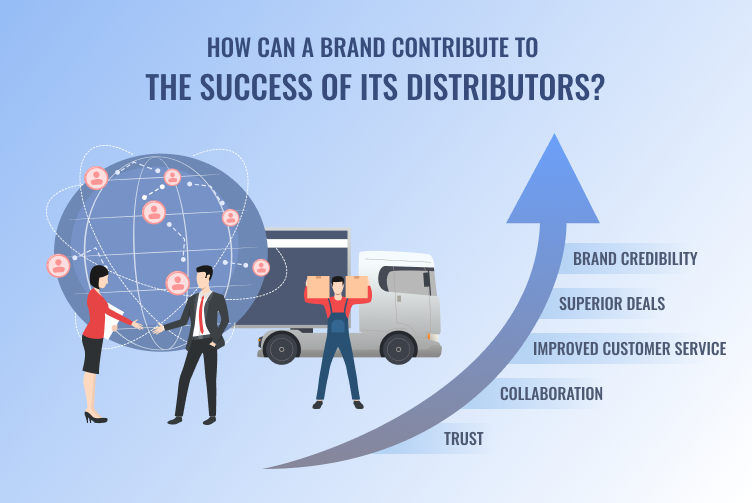The relationship between a brand and its distributor is the foundation for optimal services. If a business does not have trusted distributors for purchasing, delivering, and reselling, it may not be able to operate efficiently in the long run.
To get value for your investment, developing a healthy and solid distributor network is crucial. The more the distributors know the brand and vice versa, the more efficient, productive, and cost-effective the supply chain is.
Why Should a Brand and Distributor Have a Stronger Relationship?
Maintaining a great connection and rapport with the distributor is essential for several reasons. It can help the brand acquire a superior deal, build trust, and collaborate better.
When the team of distributors is agile and spirited, efficiency and customer service are boosted. Moreover, when brands share good terms with distributors, it gives them access to invaluable resources like a better perspective and the possibility of doing more business soon. As the distributor’s business flourishes, so does the brand’s.
One of the crucial elements to maintaining a stronger distributor network is to address the challenges that distributors face. Let’s expand on them.
Challenges Of Distributors
Running any business involves a lot of hard work, dedication, and effort. Especially when it comes to a distributor business, it is essential to accommodate operations efficiently. And to understand the distributor network and its functions, it is crucial to address the key challenges one by one:
Inventory Management
Inventory management is a typical issue in the distributor network. It is a complicated problem that involves concentration and precision. Inventory management is more than just monitoring the incoming and outgoing products. For instance, stock-taking is a vital aspect of inventory management. Likewise, restocking also largely depends on inventory management.
Since the process involves labour, investing in a cost-effective distribution management software or tool is wise. It can track goods and products in real-time, integrate with the cloud, and help the business stay ahead. Tools powered with AI further help predict business trends and analyse results.
Lack of Transparency in the Supply Chain
If the supply chain derails at any point, it breaks down the network and hampers the delivery channel. Thus, you may not be able to deliver products on time to satisfy customers’ demands.
As there are layers and layers of middlemen involved in a distributor network, each layer adds complexities while decreasing the ability to achieve visibility and transparency in the supply chain. Distributors also admit that they have little to no visibility into the supply chains. If any supply chain layer breaks down, it upsets the industry.
Technologies Taking the Lead
While there are brighter sides to the increasing use of technology, its adoption needs a strategic approach and a careful plan, alongside resource management, to back it up.
Technologies available in the market help meet the stringent and soaring demands. Powerful and mature software solutions and tools such as automation resources to simplify and streamline processes, GPS devices for tracking fleets, and paperless solutions for reducing warehousing errors, helping inventory management, and lowering the cost of labour – all these are a must. Without these technologies, distributors would not be able to meet the rising demands.
Migration to eCommerce
Just as consumers approach eBay and Amazon to purchase their books, laptops, smartphones, clothing, etc., they are now also pursuing the use of eCommerce for business-related deals. B2B buyers have turned online to shop for their essentials and have a fully functional eCommerce website and customer portal with a profound online presence.
Distributors must catch up to the trend and must evolve with the times. Otherwise, as competition intensifies, the gap between them and the consumers will widen.
Ways to a Cohesive Bond Between Brand and Distributor
Compensating a distributor does not give you control or ownership of the collaboration. It is essentially two-way traffic.
Just as you want the distributor as a customer, your distributors also want the same. This implies being rational, fair, and adapting to changing circumstances. To build a cohesive relationship with the distributors, here are a few things to practice.
Work with Vendors Sharing Similar Principles
Consider vendors who focus on brilliant customer services. Build a personal relationship based on matching core principles and consider their values, ethics, reputation, and positioning before deciding. It is crucial to maintain customer relations when the return or warranty policies of items, services, or materials you purchase, deliver, or resell are all in question.
Recognise Vendor Requirements
Understand the business model of distributors to identify the issues. Consider their investors and check for stock availability for the public. Examine the goals, operation methods, and objectives of the organisation. This knowledge would help you align your business goals with theirs and grow together.
Adhere to the defined procedures to keep things simple and meet deadlines. Do not shy away from being proactive. Monitor important documentation like company details, purchase order data, and insurance certificates.
Aim to Be an Appreciable Customer
You may appreciate some customers because of their behaviour and qualities. Analyse those key qualities and inculcate them for vendors. Make payments on time and maintain correct records to prevent redundancy.
Additionally, ensure that the cash reserve of the distributor has enough funds. This would ensure that the distributors are ready to pay upfront and on time to meet the immediate needs.
Establish Channels of Contact and Maintain Them
Frequent meetings with the distributors ensure a healthy and strong collaboration. You can discuss about what is working and the areas to improve.
Keep the communication channel open to build a stronger bond. Lend a voice to your distributors to make them feel important. Let them know what’s happening inside the company – make them feel a part of it.
Timely Feedback is Important
Provide timely feedback to avoid any misinterpretation or mistakes. Although mistakes may transpire despite meticulous planning and preparation, the distributor and the brand must deal with such issues proficiently and swiftly. Make the provider a part of your solution.
If you feel that something is going awry, speak up.
Reward Loyal Customers
Reward your loyal customers and go above and beyond to show that you appreciate them. Businesses often grumble over small issues without looking into themselves to identify what is lacking. Develop and maintain a mutually beneficial professional relationship. This will directly and positively influence the bottom line and the overall supply chain.
A Step in the Right Direction
When you build a strong and reliable relationship with distributors, your brand credibility increases. Healthy connections empower brands to be better at coping with supply chain challenges and market disruptions. They also pave the way to negotiate better offers.




